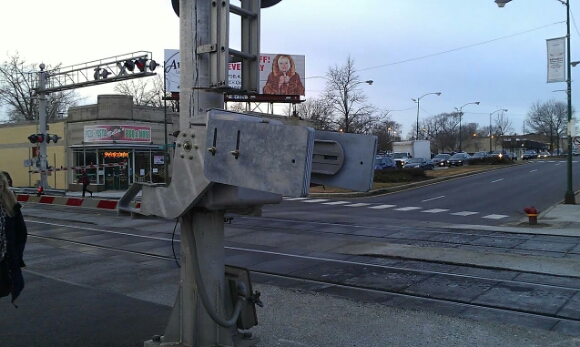How many deaths and serious injuries will it take before Metra decides that protecting pedestrians at South Side grade crossings is as important as protecting the motor vehicle occupants sitting next to them?
This week, 11-year old Alex Zepeda lost his leg when he was struck by a Metra train approaching the Blue Island-Vermont station at the Winchester Street crossing, which has automotive gates but lacks gates across the sidewalk. Several of his schoolmates, who were aboard the school bus he was running to, were traumatized by the sight. Alex saw the bus cross the tracks, then dashed under the gates blocking the road. A lower, sidewalk-level gate might have stopped him in time.
In 2012, a young mother was struck and killed by a Rock Island train at 95th Street and Vincennes Avenue, and a woman was fatally struck by a Rock Island train at 95th and Wood streets in 2010, a busy crossing that also lacks pedestrian gates. In fact, there is a collision nearly every week between trains and pedestrians or vehicles in this section of the Metra service area.
The number of grade crossings where pedestrians are at risk on the far South Side is staggering:
- Metra Electric District, Blue Island branch: 24 grade crossings over 3.5 miles of track, from 121st and Michigan to Blue Island-Vermont station. No pedestrian gates, even at Union Street, where the Major Taylor Trail crosses the line.
- Rock Island District, Beverly branch: 29 grade crossings over 6 miles of track, from 89th and Aberdeen streets to Blue Island-Vermont station. Of these, only one crossing (at 89th and Aberdeen) has pedestrian gates.
- Rock Island District, main line: 16 grade crossings over 4.8 miles of track, from 95th Street and Vincennes Avenue to Blue Island-Vermont station. The crossing at 102nd Place lacks sidewalks, so the crossing gates for vehicle traffic double as pedestrian gates. This line carries heavy Metra and freight traffic, including high speed express trains.
- Total: 69 grade crossings over 14.3 miles of Metra tracks, within the 16 square mile area bounded by 89th and 130th streets, and Michigan and Western avenues -- and only one crossing has pedestrian gates.
Many other busy grade crossings across the Metra system have pedestrian gates, notably those at Riverside, Edison Park, Arlington Heights, and Wilmette stations. Sure, these locations have significant pedestrian traffic at rush hour, but that's also true for 95th-Beverly Hills, Blue Island-Vermont, and other stations within the area discussed above. During the time I’ve lived in Beverly, I’ve witnessed near-misses at 95th every week.
There is no excuse for Metra to fail to protect pedestrians at stations like Blue Island-Vermont, 95th-Beverly Hills, and others that serve hundreds of passengers each weekday. Pedestrian gates are a recommended practice for any crossing with "moderate" pedestrian volumes. Gates don't even need to be expensive automated designs. Simple swing-arm gates with warning signs (see figure 77) have proven to be an effective deterrent in cities where light rail trains frequently cross city streets.
Installing gates would not eliminate pedestrian crashes, but they would significantly improve the odds that pedestrians would stop and not tempt fate by walking through the grade crossing -- particularly for children who might not yet understand that they, too, must stop when the cars do.
Updated December 21 to clarify the alternate gate design.




